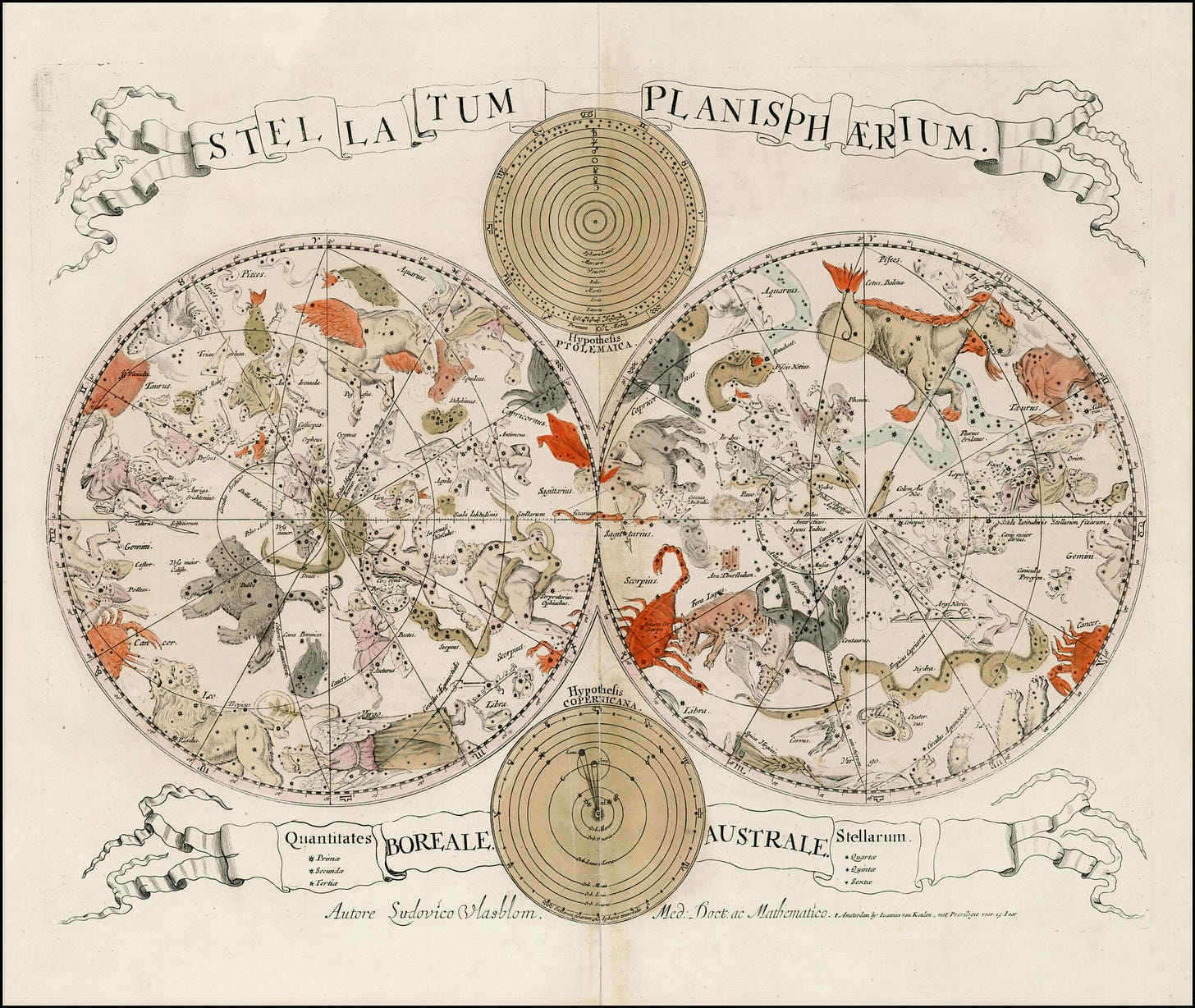#1 Welcome to Dig It!
Exploring the world of digital cultural heritage together
We curate the world of digital cultural heritage for you

Stellatum Planisphaerium. Johannes Van Keulen/Louis Vlasbloem, 1645. Public Domain.
Welcome to the very first issue of Dig It!, your bi-monthly newsletter on all things digital and cultural heritage. This is a platform to explore and discuss inspirational examples of GLAMs in the field of digital media, tools and practices. We believe in open conversations and learning by sharing experiences. It’s our mission with Dig It! to enable discussions about digital heritage practices and spark inspiration for your own projects and endeavours. That’s why we encourage you to use #GLAMsDigIt and join the conversation!
In this edition, we are discussing rapid-response collecting, diversifying the understanding of the open access landscape, and AI creating community experiences.
Before we dig deeper into this - who are we actually? Let’s take a short moment to introduce ourselves as your stewards on this endeavour: We are Medhavi Gandhi and Larissa Borck. We’re based in India and Europe and are both professionals within the field of digital cultural heritage. Although we have never met in our analogue lives, we stumbled across our digital paths so often, that we simply couldn’t resist working with each other any longer. If you’re curious, you can find out more about us here.
1. Let’s Talk About…* rapid-response collecting
Larissa: Next week, I'll be leading a session on sustainability and long-term effects of digital transformation in GLAMs during the Annual Swedish Museum Conference. One of the examples is the Nordic Museum in Stockholm and their rapid-response collecting campaigns. After several years of running these initiatives, they have gained a lot of experience with the platforms they’re working with and have built skills within the team to respond as soon as possible to current events. They’ve had campaigns about the 2017 terrorist attack in Stockholm and are currently running one on COVID-19 stories.
Rapid-response collecting solves an issue (to a certain degree) I stumble across again and again when it comes to museum collections: Whose stories are worth preserving? A few years ago, I visited an open-air museum with my grandmother, and one object sparked her memory. She told me how she observed her mother using that tool during her childhood. Neither my grandmother nor her mother’s stories are preserved in museums because they aren’t considered notable enough. However, rapid-response collecting shows your audiences that when an event matters to your community, the museum is taking the time and resources to listen to their experiences. It doesn’t take them weeks or months to get the infrastructure settled or to decide upon the right way to address the audience. Instead, they’re right there for you when you need someone to listen. Isn’t that a step in the right direction?
Medhavi: Rapid-response collecting as part of a museum’s collection strategy is not only a step in the right direction - but also a refreshing one. This is an agile process - a key characteristic of a digitally transforming world. However, an issue is the authority of representation. How does digital crowdsourcing relate to authority? In a country like India (where the pandemic-induced shift to online classes forced many students from low-income families to drop out of school because of a lack of digital infrastructure and resources), if museums were to digitally crowdsource COVID-19 stories, who would they be representing?
Of course, our lives today cannot be imagined without digital and our collections should reflect this societal change. Mr. Jan Behrendt (Head of Collections & Research at the Militärhistorisches Museum, Berlin) rightly pointed out to me, that for digital objects to be accessible over a period of time, it will need sufficient staff skills (IT, or even legal!). This makes me curious about museums’ approaches towards the infrastructure needed for long-term strategies for preserving these collected stories.
→ Where is your museum turning when a flood hits your region, a technical development makes a life of work experience obsolete, or a crucial rite de passage changes the lives of people in your society? How do you make sure to collect diverse stories that really represent your community’s experience?
2. The Written Word:
“Open GLAM in Nigeria — developments and opportunities for open access” by Isaac Oloruntimilehin

Eko cater bridge in Lagos State, Nigeria by Omoeko Media, CC BY SA 4.0.
Larissa: In 2020, the Open GLAM Medium publication is trying to increase diversity and representation on its platforms. Too often, GLAMs from the Global North are dominating the digital cultural heritage scene. Earlier this year, Creative Commons launched an open call to support voices from other parts of the world to share their Open GLAM stories. 16 articles are going to be published - and in this one, Isaac Oloruntimilehin describes the situation of open access to cultural heritage in Nigeria.
“The greatest challenge to promoting free and open access to digital cultural heritage in Nigeria is awareness. Many cultural institutions in Nigeria are unaware of open practices in promoting access and reuse. For those who are aware but undecided, it still demands a great deal of advocacy to convince them to give their first steps.” - Isaac Oloruntimilehin
Medhavi: In India too, we face the challenge of familiarising GLAM institutions with open access and its correlation with audience reach and impact on future revenues. Since so many institutions still think they can generate revenue with the sale of image rights, open access is largely in the realm of “threat” and not “opportunity” or “strength”. While Wikimedia projects like Art+Feminism or photo challenges are welcomed by many cultural institutions, there’s always a need to understand the impact. This is particularly interesting because digital reach through Wikipedia page views or downloads, for example, are not recognised as success metrics!
3. And Now For Something Completely Different
Medhavi: On August 15, India celebrated its Independence Day. In a partnership with Google, India's public service broadcaster, Prasar Bharati used AI to power a crowdsourced singing of the national anthem! By opening a web-based browser app, you could sing the anthem karaoke-like into your phone - and the app transforms it into one of three instruments to choose from. In the end, many of the voices were combined to create a choir of those contributions. Find out more about this here.
Larissa: Singing national anthems together isn’t possible this year - in this example, technology such as AI enables people creating something big together, safely apart from each other. And you don’t only contribute to something where you might not be able to identify your own contribution at the end - you even get a nice creative output yourself. This aspect of reciprocity - what does the contributor give, what do they get? - is often neglected in the cultural heritage sector.
4. Shout-out to… David Nuñez

We feel you, David.
5. Upcoming
Re:publica, one of Europe’s most advanced conferences on the digital society, kicks off a month full of interesting weekly topics with MuseumFutures, a free online symposium from September 7 to 11, 2020. It will bring together “international thought leaders from culture, science, art and politics […] discuss[ing] the current situation of museums, their challenges and opportunities in the 21st century”.
The Museum Computer Group will host the virtual Museums+Tech conference in December. It’s dedicated to “Museums in a crisis” and the Call for Proposals closes on September 11.
Copyright can be a real nuisance, to be honest. Europeana is trying to support professionals in the cultural heritage sector with a dedicated webinar series starting on September 22.
“Ask a Curator” Day celebrates its 10th anniversary on September 16! Are you thinking about participating? Here’s a guide that tells you what to expect, how you can participate and make the most of this globally popular event! You can also find the logo assets here.
We are truly honoured that you, dear reader, took the time to read Dig It!, our take on digital cultural heritage. If you haven’t subscribed yet, but we managed to convince you with this first issue, why not do it right away?
And if you liked this newsletter, please consider sharing it.
Please don’t hesitate to get in touch with feedback using #GLAMsDigIt, leaving a comment or via newsletter.dig.it@gmail.com!
All the best,
* We’re going to use recurring categories to structure this newsletter. What do you think about them?


